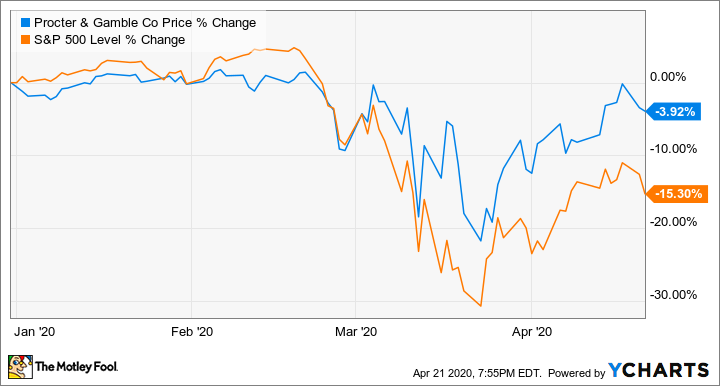Procter & Gamble (PG +0.23%) has become a hot stock to watch in recent weeks. The changes in consumer behavior brought about by the COVID-19 pandemic have sparked renewed interest in many of the consumer staples for which the company has become known.
Now, with earnings season having just begun, many investors will likely look for any glimpse of how this crisis affects earnings. As some consumer staples saw a surge in sales, these companies can buck the trend of economic decline with widespread store closures and millions of people out of work. However, Procter & Gamble's earnings may at best offer a limited view of what will come for investors.
P&G missed estimates despite sales increases
Coronavirus has caused products such as toilet paper and hand sanitizer to fly off the shelves. In this environment, one might expect a company like P&G to outperform.
The company did provide some cause for optimism. In its fiscal third quarter (which ended March 31), P&G reported core earnings of $1.17 per share, a 10% increase year over year and topping analysts' consensus expectation for $1.13 per share. Net sales of $17.21 billion also rose 5% from year-ago levels. This also accounts for a 10% increase in U.S. sales and a corresponding 8% decline in China.

Image source: Getty Images.
However, other metrics fell short of expectations. Revenue missed estimates by approximately $80 million, and GAAP earnings of $1.12 per share were five cents below the consensus.
How Procter & Gamble stock reacted
The investor response was muted as Procter & Gamble stock traded up just over 2.6% following the April 17 announcement, matching the day's 2.7% gain for the S&P 500.
That said, Procter & Gamble stock has recovered quickly in the past several weeks, while the S&P 500 still suffers double-digit losses year to date. Procter & Gamble stock looks like a missed buying opportunity in this context, and that reflects the relative strength of the company within its industry. P&G continues to outpace the five-year average growth rates of peers such as Kimberly Clark and Colgate Palmolive, according to analysts' estimates.
Data by YCharts.
So what do the results tell us?
Management indicated on the earnings call that they believe this change in sales is not temporary. Certainly, the numbers pointed to some bright spots such as the 6% increase in organic shipment volume.
And investors might have expected positive revisions to both sales and earnings guidance, but this did not happen. Management only reaffirmed its fiscal 2020 guidance for organic sales of 4% to 5% growth. The company similarly stuck to its forecast of 8% to 11% core earnings per share growth this year.
Stockholders should also note the relatively limited amount of data available as the latest quarter ended on March 31. Moves to contain the outbreak in the U.S. did not take hold until the latter half of the month, leaving just a few weeks for elevated demand for consumer staples to be reflected in the report. For this reason, investors may not see concrete numbers reflecting the full effects of the pandemic on P&G until later this year, but as management noted during the call, "There's a very wide range of possible near-term scenarios, and it's futile to spend too much time trying to assign probabilities to each. We'd be fooling ourselves and fooling you to try."
Another takeaway for investors is how this report could offer a preview of what to expect from other consumer-staples companies. Procter & Gamble's peers will also have only a few weeks of results compiled, and this short timeframe offers a limited glimpse of the current environment. While headlines regarding empty store shelves and the hoarding of supplies may point to an extended boon for P&G, investors should follow management's lead and remain cautious until sufficient data helps paint a fuller picture of how the coronavirus will affect results for the remainder of 2020 and long term.









